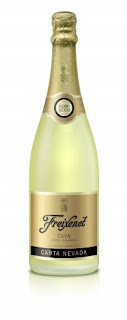Good
$10-$13 Range
Domaine Saint Michelle; Washington State;
Non-Vintage
Driest: Blanc de Noirs
Medium: Brut
Slightly Sweet: Extra Dry
These are all great buys and are true "Method Champenoise" bubblies. Always rated as a "Best Value" or "Best Buy" buy the big wine magazines. If you need several bottles for a party....you shouldn't look any further than Domaine Saint Michelle.
 Note: Domaine Saint Michelle has recently changed the label color. You might encounter a bottle that looks like the one to the left.
Note: Domaine Saint Michelle has recently changed the label color. You might encounter a bottle that looks like the one to the left.If you like your sparkling wine a little on the sweet side, you should give this one a try. This Spanish Cava is a good deal at around $10
Freixenet
Carta Nevada
Semi Dry
NOTE: This wine comes in three levels of sweetness: Semi-Sweet/Demi-Sec (very sweet to me); Semi-Dry/Semi-Sec (similar to an extra dry champagne in terms of sweetness) and Brut (least sweet). Look at the bottles carefully as it is easy to grab the wrong one.
Better
$19-$25 Range
If you like Sparkling Wines and are willing to part with a $20 bill, hear are a few that I suggest:
Gloria Ferrer
Sonoma Brut
NV
Mumm Napa
Cuvee "M"
NV
Roederer Estate
Anderson Valley Brut
NV
All of these wines are produced by the American arms of big European sparkling and Champagne houses.
Gloria Ferrer is located in Sonoma and has a gorgeous vineyard and visitor center. It is owned by the Spanish company Freixenet (you know, that solid black bottle you always see in the stores).
The Gloria Ferrer Sonoma Brut was listed in Wine Spectator's October issue as one of the "Top 100 Most Exciting Wines of 2009." At $20 or under it is a good deal. It is a classic Brut, dry and crisp.
The Mumm Napa Cuvee "M" is produced by Mumm Napa, the American arm of the giant G.H. Mumm Winery, Reims, France. G.H. Mumm also produces one of the most famous non vintage Champagnes, Mumm Cordon Rouge. As a result of the long history and tradition of its parent company, Mumm Napa produces consistently good sparkling wines.
The Cuvee "M" is (of course) a cuvee meaning that it is a blend of Pinot Noir, Chardonnay and perhaps other grapes from various vintages. This wine is creamy, easy to drink and has just a hint of sweetness. I really like this as an apertif or for that special celebration where you just want a nice bottle to open up. This is a really good choice.
Roederer Estate is located in the Anderson Valley of Mendocino County (it is a beautiful place to visit, by the way) and is the American arm of yet another French Champagne house. Have you ever heard of "Cristal?" (the bottle to the left) You might have seen it wrapped neatly in cellophane behind the counter of your favorite wine shop (cost $250 or so). Louis Roederer is (like Mumm) located in the Champagne center of Reims, France, and produces numerous high-end Champagnes.
Several years ago they opened an American facility in the Anderson Valley area of Mendocino County. Located a little north of the Napa and Sonoma areas, Mendocino is full of big hills and closer to the Pacific. The result is slightly cooler temperatures which produce some really flavorful wines.
The Roederer Estate Anderson Valley Brut is consistently rated as a good buy. I first discovered this wine about ten years ago after a favorable review in the Wall Street Journal. It has been one of my favorites ever since. It is a classic Brut sparkling wine and is a nice addition to any dinner or party.
Even Better Yet...
$40-$50 Range
My favorite choice:
Moet & Chandon
"Imperial"
This wine was known for years as "White Star" and has been my personal favorite since I had on my honeymoon with my (now) ex-wife nearly twenty years ago.
This would classify as an "extra dry" champagne as it has just a touch of sweetness. Too much talking ruins a good thing so I'll shut up about this one. I like it!
Note: You may find "White Star" instead of Imperial. No bothers. While slightly reformulated, you will still like it. White Star still on the shelf is just fine.
Another Favorite......
Veuve Clicquot-Ponsardin
"Yellow Label" Brut
non-vintage
This is one of the most recognizable Champagne bottles (after Dom Perignon, which is noticeably absent from this blog.....). The bright yellow-orange label is synonymous with a good quality sparkler.
While it does come in "sec" (sweet) and dem-sec varieties, it is the Brut that is well known and respected. This wine is clean, crisp, full flavored and very dry. It is also a non-vintage cuvee and has more Pinot Noir than Chardonnay. Another "can't miss" with this one....but its dryness is not for the champagne virgin. You'll be wasting your money.
On my Christmas wish list to try....
Armand de Brignac Brut Gold
This baby just hit the market. At $249 it is not cheap but promises to be something really, really special. Wine Spectator recently gave it a 94 rating (very high) and the critics say it is amazing.
The bottle is a shiny gold and has a pewter label on the front. It often is packaged in a nice little wooden box lined with satin.
If you like Champagne and have a special day coming up...this might be one to consider.
One last thing...
If you are looking for a sweet, dessert-style sparkling wine, you might want to give this one a try. While I'm not a big fan of really sweet wines, I do find this one fun and easy to drink. I think it is great with a chocolate dessert. The ladies really LOVE this one!
Rosa Regale
Banfi- Italy
Price: around $20 for the standard size 750ml bottle
Available in 187, 375, 750 and 1.5 liter bottles













